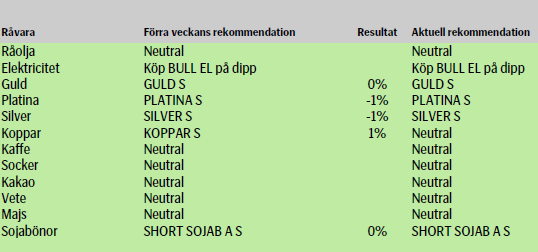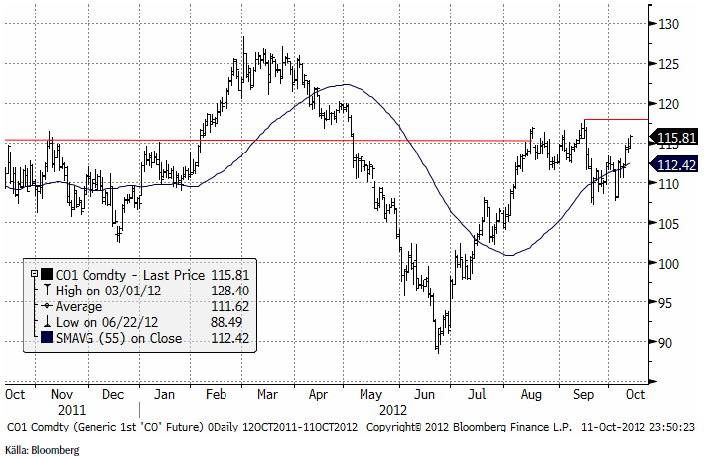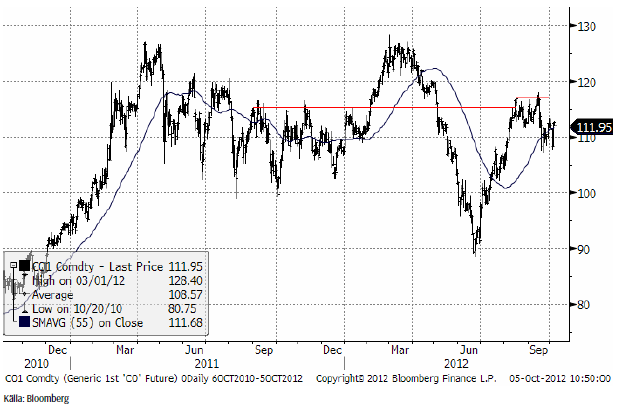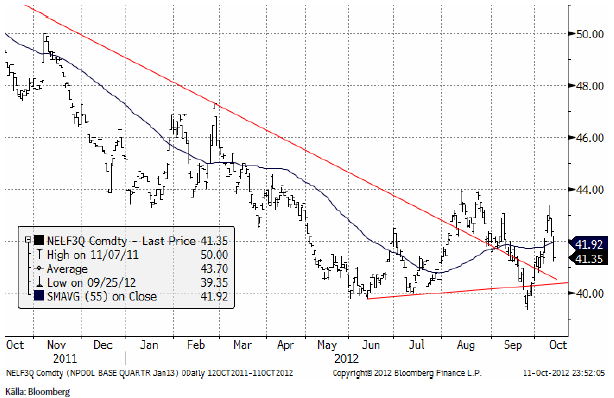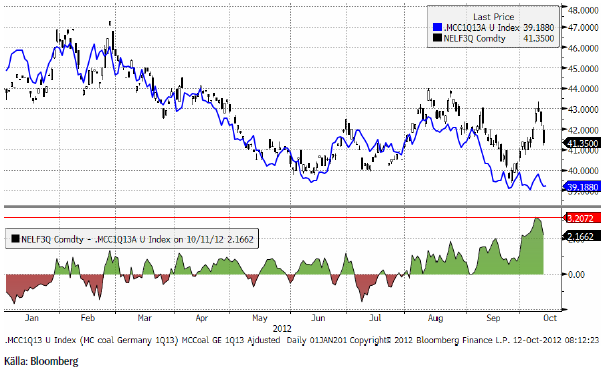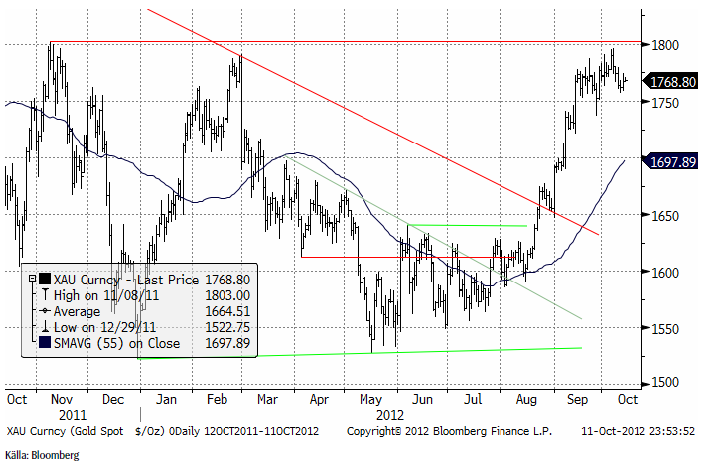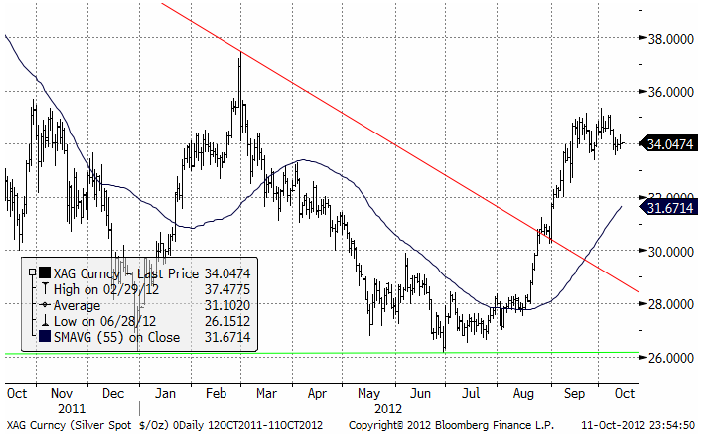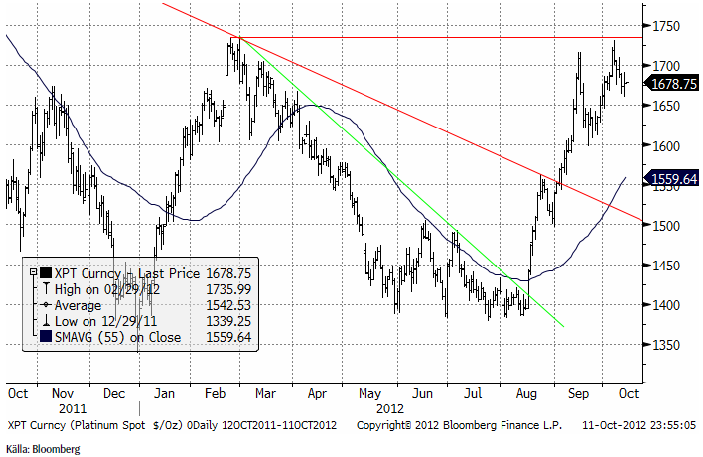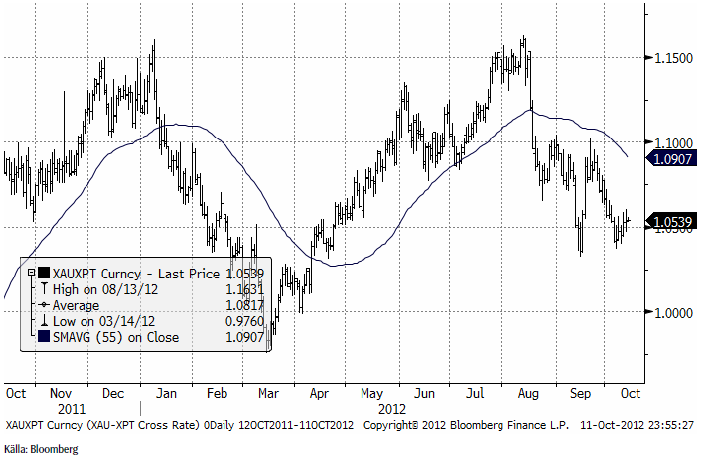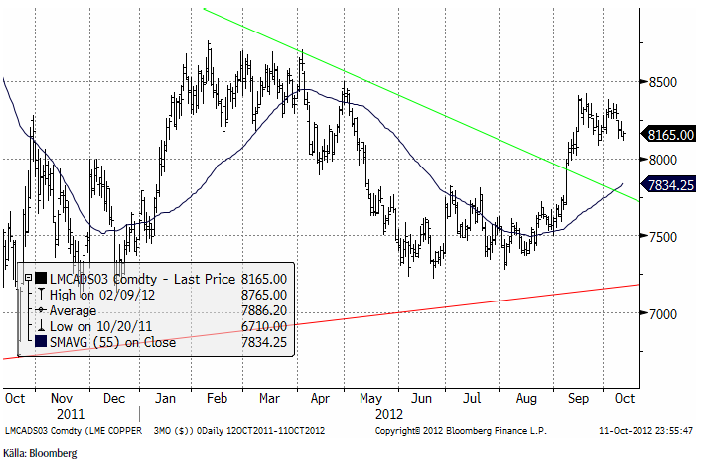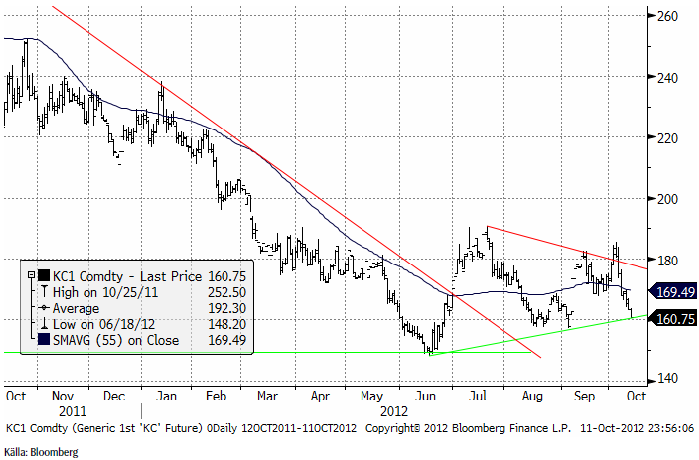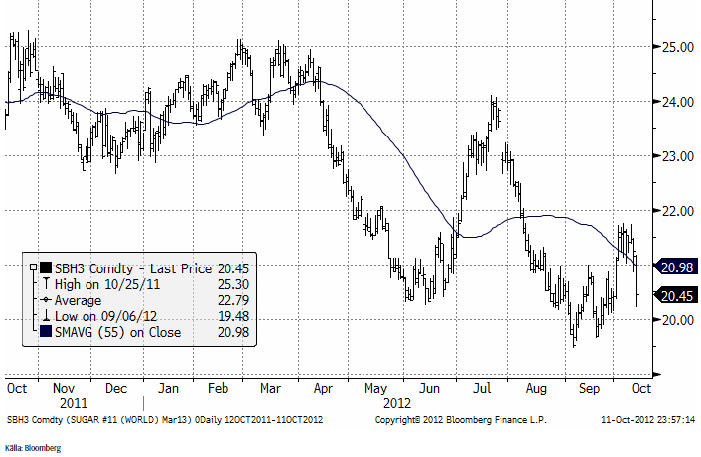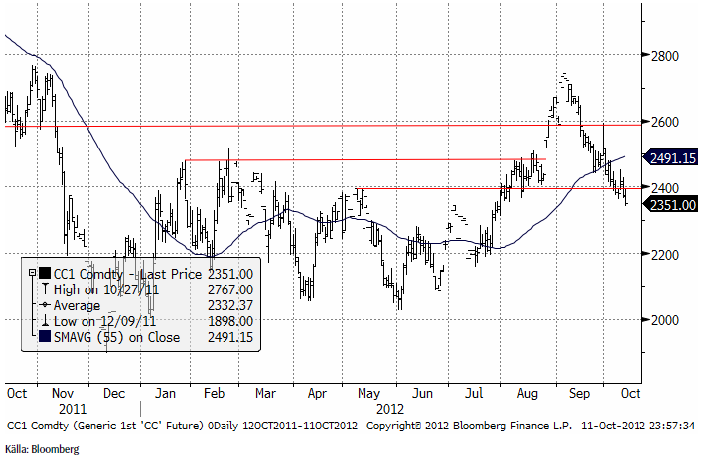Analys
SEB – Råvarukommentarer, 12 oktober 2012
Sammanfattning av rekommendationer
Förra veckans rekommendationer gav en samlad förlust på 1%. Vi väljer att kliva av koppar för närvarande. Såväl ädelmetaller som koppar, handlas inom ett intervall som kan vara en tillfällig topp eller en konsolidering. Om priserna bryter upp är det en signal om ytterligare prisuppgång, och vice versa om priserna faller. Ädelmetaller är långsiktigt på väg uppåt, så vi väljer att ligga kvar på dem. Man kan köpa mer om guld går över 1800 dollar. Platina har ett annat tekniskt mönster. Priset har kommit ner så pass att den är värd att köpa mer av nu.
Elpriset har fallit av ganska kraftigt de senaste dagarna, och om priset faller ner mot 40 euro kan det vara ett köptillfälle för den som vill handla på kort sikt.
Råolja – Brent
Vid en tillbakablick på det tredje kvartalet, så var det för Brent ännu ett turbulent kvartal. Brent handlades till ett snittpris på USD 109,4/fat, USD 0,6/fat under vår prognos. Eftersom flera stora hausse- och baissefaktorer fortfarande är aktuella tvivlar vi på att oljemarknaden kommer att vara speciellt mycket lugnare under det fjärde kvartalet. Vi anser dock USD 110/fat vara en solid utgångspunkt för Brent och diskonterar större makroekonomiska och geopolitiska osäkerheter tämligen väl. Det säkerställer också att kassaflöden förblir tillräckligt starka för att göra välbehövliga investeringar i framtida leveranser. Enligt vårt huvudscenario förväntar vi att Brent, grovt räknat, har ett genomsnitt på USD 110/fat under det fjärde kvartalet i år. Därefter förväntar vi oss ett säsongsmässigt lägre pris på USD 105/fat under det första halvåret nästa år, med återhämtning till USD 115/fat under andra halvan av nästa år, när makroekonomiska förhållanden stabiliseras. Uppenbara nedåtrisker på kort och medellång sikt inbegriper möjligheten att sanktioner kan tvinga Iran tillbaka till förhandlingsbordet, att USA möjligen släpper ut strategiska oljereserver samt oviss efterfrågan från Kina. Nedan ser vi kursdiagrammet för spotkontraktet på Brent.
Priset på Brent-råolja har på sistone pressats upp till över USD 114/fat genom flera haussefaktorer. Extensivt samt väsentligen försenat underhåll i Nordsjön har minskat tillgången på råolja från Nordsjön med förseningar i nästan alla lastningar i oktober. Lastningar i november kommer också att påverkas och de nuvarande förväntningarna är att lastningarna i november kommer att vara de lägsta på 5 år. En annan fysisk drivkraft för Brent-råolja är för närvarande de låga förråden av oljeprodukter av mellandestillat i Europa, kombinerat med så mycket som 2 miljoner fat per dag för raffinaderiunderhåll. Raffineringsmarginalen för mellandestillat är på årshögsta eller flerårshögsta och signalerar knappheten i detta segment. Denna knapphet inträffar under en tid på året när vi fortfarande har en stor del påfyllning framför oss under de kommande månaderna. Lättoljor som t.ex. Brent är den råolja som föredras av raffinaderier när de fysiska marknaderna för lättoljeprodukter eller mellandestillat är strama. Därför stärker den nuvarande knappheten avseende mellandestillat efterfrågan på Brent-råolja.
Framöver kan Mellanöstern- och Nordafrikaregionens geopolitiska påverkan på oljemarknaderna vara både hausse- och baissebetonad. På haussesidan ökas spänningar längs den syrisk-turkiska gränsen med ökad risk för regional smitta och möjlig Natoinblandning. På baissesidan visar Iran tecken på att krokna under trycket från sanktioner. Sprickor börjar visa sig här och var. Snabb inflation ökar den sociala oron, vilket potentiellt skulle kunna tvinga Iran tillbaka till förhandlingsbordet och därmed minska riskerna för oljetillgången.
Flera faktorer på utbudssidan har mildrats; Det verkar som sanktionerna mot Iran börjar ge resultat. Regimen pressas sedan tidigare av uteblivna intäkter från oljeexport. I september exporterades 1.15 miljoner fat/dag jämfört med 2.4 miljoner fat/dag i genomsnitt förra året. Nu har dessutom uppvärmningssäsongen inletts. Iran har, trots att man är stor nettoexportör av råolja, inte tillräcklig raffinaderikapacitet för att förse den inhemska marknaden med oljeprodukter som bensin, diesel och olja för uppvärmning. Istället måste man köpa dessa produkter på den internationella marknaden – till höga priser (bland annat p g a sanktionerna). Att den egna valutan dessutom urholkats i värde gör inte saken bättre. Höga matpriser har redan drivit upp inflationen och nu är situationen än värre. Trycket på regimen är så stort, att chansen för att man återgår till förhandlingar med USA och EU, är bättre än på länge.
I september var rekordstor kapacitet i Nordsjön borta från marknaden p g a underhåll och reparationer. Många av dessa arbeten är försenade men vi räknar ändå med att utbudet snart ökar, vilket bör mildra pressen uppåt på olja. Vi har också passerat den säsongsmässiga toppen på orkansäsongen utan några allvarliga implikationer på oljemarknaden (med undantag för Isaac som kortsiktigt störde produktion och distribution i mexikanska gulfen).
Trots ovanstående argument för nedsidan, så ser vi värde kring Brentpris kring nivåer där priset tidigare vänt åter upp (kring 107-108 usd). Detta då den geopolitiska situationen i Iran och Syrien m fl länder fortsatt verkar för en premie på oljepriset. I skrivande stund handlas kontraktet på 110.20, där vår rekommendation, förblir neutral.
Elektricitet
Nedan ser vi priset på första kvartalskontraket 2013 på el, som är underliggande för våra certifikat. Priset har rekylerat kraftigt de senaste dagarna.
Vi har tidigare kommunicerat att 40-nivån på Q1-13 terminen (den termin som våra certifikat replikerar) är en attraktiv ingångsnivå för en long position. Vi håller fast vid detta, då nedsidan därifrån bör vara begränsad, detta för att:
- CO2 priset: Uppside potential på förhoppningar om politisk intervention i CO2 marknaden
- Kolpriset: Har planat ut och nedsidan är begränsad.
- Prispremien för problem med kärnkraft- och för köldknäppar i vinter ger stöd for Q1-13
Kontraktet handlas nu på 41,3 efter att det nyligen tradat upp till €43.35/MWh driven av signaler på torrare och kallare väder. Däremot har inte uppgången varit förankrad i en annan viktig prisdrivare, marginalkostnaden för koleldad kraftproduktion, se grafen nedan.
I den nedre delen i diagrammet ovan, ser vi hur differensen mellan Q1-13 (NELF3Q Comdty) och vårt kontinentala index for marginalkostnader drivits upp till en nivå där den tidigare fallit tillbaka. Den 8 oktober var differensen uppe i €3.2/MWh. Den här differensen har nu korrigerats till mer normala nivåer. Det är fortsatt mycket god tillgång på vatten i det nordiska kraftsystemet. Magasinen är fulla och den hydrologiska balansen är på ca +12 TWh. För en rejäl uppgång behöver kontraktet stöd av både väder och marginalkostnader.
Det ser ut som om marknaden kan ge en ny möjlighet att köpa Q1-13 på nivåer nära €40/MWh. En sådan position, t ex genom köp av BULL EL X4 S, ger en position med begränsad nedsida samtidigt som det ger möjlighet till prisuppgångar från chansen att något av följande faktorer slår in: risken för kallare och torrare väder, kärnkraftproblem, CO2 interventionsoptimism samt en möjlig uppgång i kolpriset under början av vintern, som står for dörren.
Guld och Silver
Konsolideringen har fortsatt under veckan, fortsatt utan genombrott. Förra veckan testade marknaden nästan $1800-nivån, men fallerade och handlas nu mitt i intervallet kring $1770. Vi kvarstår med bedömningen att behålla guldet om man redan har köpt, och öka eller köpa nytt vid ett genombrott av $1800. Nedan ser vi kursdiagrammet för guld i dollar per troy ounce.
Nedan ser vi kursdiagrammet för silver i dollar per troy ounce.
Platina
Platina har fallit tillbaka med övriga metaller, men uppvisar en mer positiv trend. Veckans rekyl bedömer vi som ett bra köptillfälle.
Vi tror på ädelmetaller som placering i nuvarande makromiljö. Den oroliga utvecklingen i Sydafrika har redan påverkat utbudet märkbart. Vi tror att platina priset kommer att utmana igen och återgå till ”normaltillståndet”, d.v.s. att vara dyrare än guld.
Nedan ser vi priset på guld dividerat med priset på platina. Vi väntar oss att platina ska fortsätta vinna på guldet.
Koppar
Veckan inleddes med ett prisfall på 1-1,5 % när kineserna kom tillbaka på säljsidan, efter en veckas ledighet (Golden week). Samtidigt hade USA stängt i måndags (Columbus day) så likviditeten var begränsad. IMF reviderade ner prognosen för den globala tillväxten till 3,3 % 2012 och en långsam återhämtning till 3,6 % nästa år. De tror dock på en relativt stark kinesisk tillväxt på 7,8 % och 8,2 % nästa år. Eurogruppens möte skapade oro i måndags, men beskeden på tisdag morgon, att den permanenta räddningsfonden (ESM) formellt godkändes, fick stämningsläget på världens finansmarknader att stabiliseras – och så även metallerna. Sett över hela veckan är det ändå relativt kraftigt nedåt, mellan 4 och 5 %. Sämst gick det för aluminium som föll efter Alcoas resultatrapport, där bolaget reviderade ner sin globala efterfrågetillväxtprognos för 2012 från 7 till 6 %. Koppar är den ”lysande stjärnan” med endast en marginell nedgång under procenten (se nedan).
Koppar
Vi har tidigare varnat för effekten efter stimulanspaketen, måste följas upp av industriell efterfrågan. Det har inte riktigt materialiserats, och priserna faller tillbaka. Vi är nu i början av det säsongsmässigt starkaste kvartalet, så en förbättring bör skönjas de närmsta veckorna. Jämfört med övriga basmetaller så håller koppar väldigt bra. Som vi nämnt tidigare är kopparmarknaden i grunden fundamentalt stark. International Copper Study Group (ICSG) redovisade en rapport gällande balansen mellan utbud och efterfrågan. För 2012 bekräftas den strama marknaden och de bedömer ett underskott om ca 400 tton, och det är tight med tanke på ett synligt lager börslager på LME om 220 tton. Det är naturligtvis inte allt, men en stor del av det som finns utanför Kina. Rykten gör gällande att minst 600 000 ton ligger i kinesiska frihamnslager. I vilket fall som helst så betyder underskottet en teoretisk lagerminskning på 400 000 ton. Risken finns därför att det kortsiktigt blir väldigt ont om koppar utanför Kina. För att det kinesiska lagret ”ska börja röra på sig” dvs skeppas från Kina, krävs sannolikt ett högre kopparpris på LME. Koppar är köpvärd.
Vi väljer att på kort sikt rekommendera en lång position i koppar.
Kaffe
Kaffepriset har fortsatt att fall i pris och ligger nu precis på dubbla stöd. Dels stödlinjen mellan bottnarna som är inritad som grön linje i diagrammet nedan, dels stödet i och med den jämna prisnivån 160 cent per pund. Sälj på brott nedåt av stödet. Annars kan den flinke försöka köpa med en stop-loss strax under stödet.
Socker
Nedan ser vi priset för leverans i mars nästa år. Trots ett starkt stöd vid 20 cent, ser vi tydligt att den långsiktiga trenden är nedåtriktad.
Kakao
Kakaopriset är nere en nivå där det borde finnas stöd.
Vi väljer att vara neutrala i kakao till nästa vecka.
För spannmål och övriga jordbruksprodukter hänvisas till gårdagens nyhetsbrev om jordruksprodukter.
[box]SEB Veckobrev Veckans råvarukommentar är producerat av SEB Merchant Banking och publiceras i samarbete och med tillstånd på Råvarumarknaden.se[/box]
Disclaimer
The information in this document has been compiled by SEB Merchant Banking, a division within Skandinaviska Enskilda Banken AB (publ) (“SEB”).
Opinions contained in this report represent the bank’s present opinion only and are subject to change without notice. All information contained in this report has been compiled in good faith from sources believed to be reliable. However, no representation or warranty, expressed or implied, is made with respect to the completeness or accuracy of its contents and the information is not to be relied upon as authoritative. Anyone considering taking actions based upon the content of this document is urged to base his or her investment decisions upon such investigations as he or she deems necessary. This document is being provided as information only, and no specific actions are being solicited as a result of it; to the extent permitted by law, no liability whatsoever is accepted for any direct or consequential loss arising from use of this document or its contents.
About SEB
SEB is a public company incorporated in Stockholm, Sweden, with limited liability. It is a participant at major Nordic and other European Regulated Markets and Multilateral Trading Facilities (as well as some non-European equivalent markets) for trading in financial instruments, such as markets operated by NASDAQ OMX, NYSE Euronext, London Stock Exchange, Deutsche Börse, Swiss Exchanges, Turquoise and Chi-X. SEB is authorized and regulated by Finansinspektionen in Sweden; it is authorized and subject to limited regulation by the Financial Services Authority for the conduct of designated investment business in the UK, and is subject to the provisions of relevant regulators in all other jurisdictions where SEB conducts operations. SEB Merchant Banking. All rights reserved.
Analys
Tightening fundamentals – bullish inventories from DOE

The latest weekly report from the US DOE showed a substantial drawdown across key petroleum categories, adding more upside potential to the fundamental picture.

Commercial crude inventories (excl. SPR) fell by 5.8 million barrels, bringing total inventories down to 415.1 million barrels. Now sitting 11% below the five-year seasonal norm and placed in the lowest 2015-2022 range (see picture below).
Product inventories also tightened further last week. Gasoline inventories declined by 2.1 million barrels, with reductions seen in both finished gasoline and blending components. Current gasoline levels are about 3% below the five-year average for this time of year.
Among products, the most notable move came in diesel, where inventories dropped by almost 4.1 million barrels, deepening the deficit to around 20% below seasonal norms – continuing to underscore the persistent supply tightness in diesel markets.
The only area of inventory growth was in propane/propylene, which posted a significant 5.1-million-barrel build and now stands 9% above the five-year average.
Total commercial petroleum inventories (crude plus refined products) declined by 4.2 million barrels on the week, reinforcing the overall tightening of US crude and products.


Analys
Bombs to ”ceasefire” in hours – Brent below $70

A classic case of “buy the rumor, sell the news” played out in oil markets, as Brent crude has dropped sharply – down nearly USD 10 per barrel since yesterday evening – following Iran’s retaliatory strike on a U.S. air base in Qatar. The immediate reaction was: “That was it?” The strike followed a carefully calibrated, non-escalatory playbook, avoiding direct threats to energy infrastructure or disruption of shipping through the Strait of Hormuz – thus calming worst-case fears.

After Monday morning’s sharp spike to USD 81.4 per barrel, triggered by the U.S. bombing of Iranian nuclear facilities, oil prices drifted sideways in anticipation of a potential Iranian response. That response came with advance warning and caused limited physical damage. Early this morning, both the U.S. President and Iranian state media announced a ceasefire, effectively placing a lid on the immediate conflict risk – at least for now.
As a result, Brent crude has now fallen by a total of USD 12 from Monday’s peak, currently trading around USD 69 per barrel.
Looking beyond geopolitics, the market will now shift its focus to the upcoming OPEC+ meeting in early July. Saudi Arabia’s decision to increase output earlier this year – despite falling prices – has drawn renewed attention considering recent developments. Some suggest this was a response to U.S. pressure to offset potential Iranian supply losses.
However, consensus is that the move was driven more by internal OPEC+ dynamics. After years of curbing production to support prices, Riyadh had grown frustrated with quota-busting by several members (notably Kazakhstan). With Saudi Arabia cutting up to 2 million barrels per day – roughly 2% of global supply – returns were diminishing, and the risk of losing market share was rising. The production increase is widely seen as an effort to reassert leadership and restore discipline within the group.
That said, the FT recently stated that, the Saudis remain wary of past missteps. In 2018, Riyadh ramped up output at Trump’s request ahead of Iran sanctions, only to see prices collapse when the U.S. granted broad waivers – triggering oversupply. Officials have reportedly made it clear they don’t intend to repeat that mistake.
The recent visit by President Trump to Saudi Arabia, which included agreements on AI, defense, and nuclear cooperation, suggests a broader strategic alignment. This has fueled speculation about a quiet “pump-for-politics” deal behind recent production moves.
Looking ahead, oil prices have now retraced the entire rally sparked by the June 13 Israel–Iran escalation. This retreat provides more political and policy space for both the U.S. and Saudi Arabia. Specifically, it makes it easier for Riyadh to scale back its three recent production hikes of 411,000 barrels each, potentially returning to more moderate increases of 137,000 barrels for August and September.
In short: with no major loss of Iranian supply to the market, OPEC+ – led by Saudi Arabia – no longer needs to compensate for a disruption that hasn’t materialized, especially not to please the U.S. at the cost of its own market strategy. As the Saudis themselves have signaled, they are unlikely to repeat previous mistakes.
Conclusion: With Brent now in the high USD 60s, buying oil looks fundamentally justified. The geopolitical premium has deflated, but tensions between Israel and Iran remain unresolved – and the risk of missteps and renewed escalation still lingers. In fact, even this morning, reports have emerged of renewed missile fire despite the declared “truce.” The path forward may be calmer – but it is far from stable.
Analys
A muted price reaction. Market looks relaxed, but it is still on edge waiting for what Iran will do

Brent crossed the 80-line this morning but quickly fell back assigning limited probability for Iran choosing to close the Strait of Hormuz. Brent traded in a range of USD 70.56 – 79.04/b last week as the market fluctuated between ”Iran wants a deal” and ”US is about to attack Iran”. At the end of the week though, Donald Trump managed to convince markets (and probably also Iran) that he would make a decision within two weeks. I.e. no imminent attack. Previously when when he has talked about ”making a decision within two weeks” he has often ended up doing nothing in the end. The oil market relaxed as a result and the week ended at USD 77.01/b which is just USD 6/b above the year to date average of USD 71/b.

Brent jumped to USD 81.4/b this morning, the highest since mid-January, but then quickly fell back to a current price of USD 78.2/b which is only up 1.5% versus the close on Friday. As such the market is pricing a fairly low probability that Iran will actually close the Strait of Hormuz. Probably because it will hurt Iranian oil exports as well as the global oil market.
It was however all smoke and mirrors. Deception. The US attacked Iran on Saturday. The attack involved 125 warplanes, submarines and surface warships and 14 bunker buster bombs were dropped on Iranian nuclear sites including Fordow, Natanz and Isfahan. In response the Iranian Parliament voted in support of closing the Strait of Hormuz where some 17 mb of crude and products is transported to the global market every day plus significant volumes of LNG. This is however merely an advise to the Supreme leader Ayatollah Ali Khamenei and the Supreme National Security Council which sits with the final and actual decision.
No supply of oil is lost yet. It is about the risk of Iran closing the Strait of Hormuz or not. So far not a single drop of oil supply has been lost to the global market. The price at the moment is all about the assessed risk of loss of supply. Will Iran choose to choke of the Strait of Hormuz or not? That is the big question. It would be painful for US consumers, for Donald Trump’s voter base, for the global economy but also for Iran and its population which relies on oil exports and income from selling oil out of that Strait as well. As such it is not a no-brainer choice for Iran to close the Strait for oil exports. And looking at the il price this morning it is clear that the oil market doesn’t assign a very high probability of it happening. It is however probably well within the capability of Iran to close the Strait off with rockets, mines, air-drones and possibly sea-drones. Just look at how Ukraine has been able to control and damage the Russian Black Sea fleet.
What to do about the highly enriched uranium which has gone missing? While the US and Israel can celebrate their destruction of Iranian nuclear facilities they are also scratching their heads over what to do with the lost Iranian nuclear material. Iran had 408 kg of highly enriched uranium (IAEA). Almost weapons grade. Enough for some 10 nuclear warheads. It seems to have been transported out of Fordow before the attack this weekend.
The market is still on edge. USD 80-something/b seems sensible while we wait. The oil market reaction to this weekend’s events is very muted so far. The market is still on edge awaiting what Iran will do. Because Iran will do something. But what and when? An oil price of 80-something seems like a sensible level until something do happen.
-

 Nyheter3 veckor sedan
Nyheter3 veckor sedanStor uppsida i Lappland Guldprospekterings aktie enligt analys
-

 Nyheter4 veckor sedan
Nyheter4 veckor sedanBrookfield ska bygga ett AI-datacenter på hela 750 MW i Strängnäs
-

 Nyheter3 veckor sedan
Nyheter3 veckor sedanSilverpriset släpar efter guldets utveckling, har mer uppsida
-

 Nyheter3 veckor sedan
Nyheter3 veckor sedanUppgången i oljepriset planade ut under helgen
-

 Nyheter3 veckor sedan
Nyheter3 veckor sedanLåga elpriser i sommar – men mellersta Sverige får en ökning
-

 Analys3 veckor sedan
Analys3 veckor sedanVery relaxed at USD 75/b. Risk barometer will likely fluctuate to higher levels with Brent into the 80ies or higher coming 2-3 weeks
-

 Nyheter2 veckor sedan
Nyheter2 veckor sedanMahvie Minerals växlar spår – satsar fullt ut på guld
-

 Nyheter1 vecka sedan
Nyheter1 vecka sedanOljan, guldet och marknadens oroande tystnad



